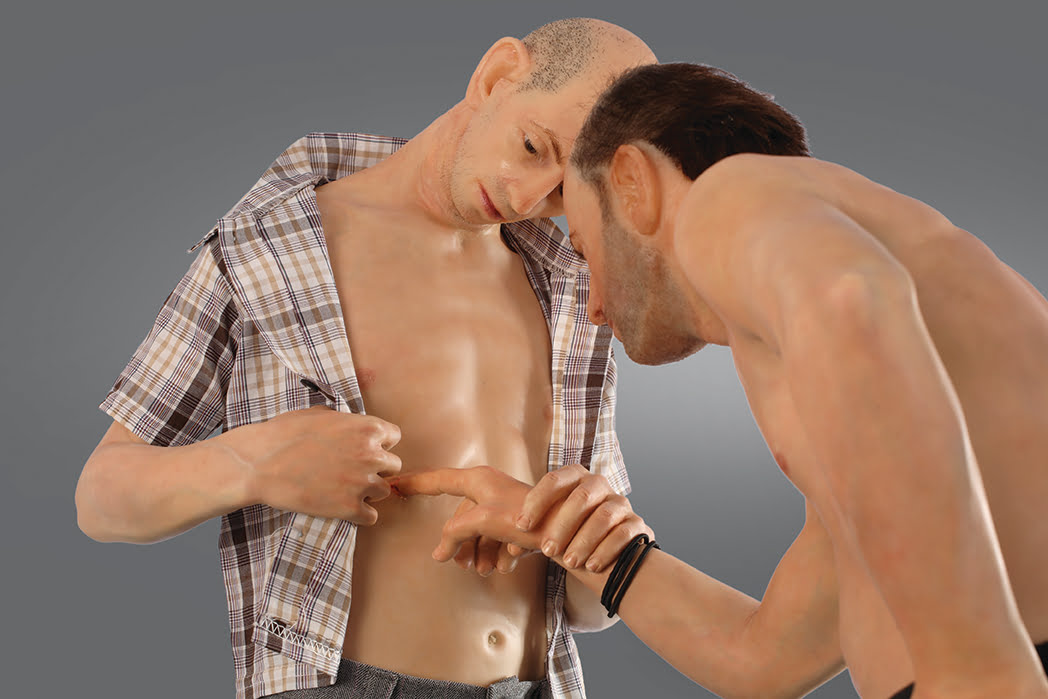A consistent creative path has brought Zharko Basheski to a top position in the world of art.
When after years of abstract sculpting and installations his sculptures became more and more figural in form, at a certain point he found himself closer to purely realist depictions, which, however, were charged with an additional quality. His figures and their faces oozed character; they extended the domain of reality, and the poses and grimaces crossed over the realistic sphere.
Quite naturally, it seems, this was followed by a transformation in terms of materials, as he moved from wood, metal, and stone to polyester, and decided to continue with hyperrealistic sculpting. Since then, his path has been constantly rising, and one of the stops on this way was his representation of Macedonia at the Venice Biennial in 2011. After that, it was hard for him to keep up with all the exhibition invitations he had received from galleries around the world.
In his works he focuses on the human being, this is why he employs a hyperrealistic approach already in shaping the concept for his statues, which, in a theoretical projection, surpasses hyperrealism and comments on life and the world in which we live.
The topics he uses for his artworks are derived from various sources, from history and mythology, which he relates to contemporary issues and the society in general, and merges them through experiences of proper affection and introspection into himself and the intimacy of family.
There are several elements in his works which are new to the world of sculpting, and this makes his latest works stand out: the concept, the contemporary views on the human condition through self-observation, the technical production and the use of new materials (polyester resins, polymarble, silicone, natural hair), the hyperrealistic treatment, the dimensions of his works, the philosophical approach – all of that which provides, when fused into one, a multifaceted reading of an artwork. Apart from this, the process of building a hyperrealistic sculture starting from the idea through the preparation phase and up to the final result, is very time-consuming: Zharko Basheski can produce one, or maximum two works per year.
It is therefore no surprise that over the past few years he has been exhibiting across America and Europe; in Mexico, New York, Paris, Bilbao, Prague, Riga, Berlin, Nürnberg, Malta and Italy, while his first appearance in Slovenia was part of the group exhibition MIG 2 – the international interdisciplinary movement, in 2016.
Since hyperealistic sculpting was never widespread among Slovenian sculptors, we decided to invite Zharko Basheski for a solo retrospective exhibition, which will take place between 17 March and 31 May 2017 at KIBLA PORTAL. All the available hyperrealistic sculptures will be showcased, while one of them has been travelling for over a year around the world as part of the exhibition titled Reshaped Reality. 50 Years of Hyperrealistic Sculpture, in the company of contemporaries like Ron Mueck, Patricia Piccinini, Maurizio Cattelan, Marc Sijan, Berlinde de Bruyckere, Paul McCarthy, and alongside legends and pioneers like Duane Hanson, George Segal, Juan Muñoz, Robert Graham, and others.
The list can be read as a who is who in the world of art, and Zharko Basheski is definitely on that list. The first hyperrealistic sculpture exhibition in Slovenia will undoubtedly attract a great deal of interest from the audience, but more than that, it will prompt expert discussions among artists, art historians, theorists and other interested parties – anyone with activated receptors.
Zharko Basheski, born 1957 in Prilep, is a Macedonian sculptor and professor at the Faculty of Fine Arts in Skopje (Department of Sculpture). Basheski is a sculptor whose monumental bronze sculptures stand on several city squares in his country, such as the statue of Alexander the Great (Prilep) and the horseman sculptures of the Macedonian national heroes Goce Delchev and Dame Gruev, in the city center of the capital Skopje.
Sculptures of men as the highest expression of the power of a civilization have always represented gods and heroes, but Basheski’s sculptures portray a common everyday man who takes on the role of a superhuman in his efforts to surpass himself. Zharko Basheski is currently a member of the Macedonian Artists Association (DLUM). His work has been presented at several international exhibitions, winning numerous awards. Much of his work is in private collections in Macedonia and abroad.
